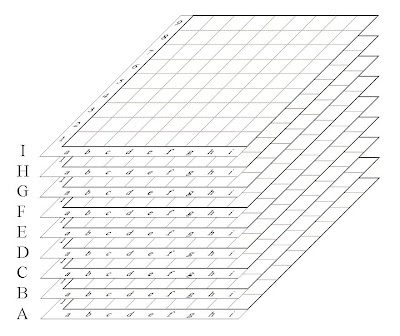Edgar Allan Poe
DOSEKI
Kosintsev I.G.
kosintsev.i.g@gmail.com
(19.07.2010)
Hello chess players!
Let me introduce the new very complex 3D game Doseki (道石).
This 729-squares (cells) board game is the acme of perfection for abstract games and has wide strategic and tactical possibilities and at the same time is using a classical set of red (white) and black checkers. In the game Go is used for comparison the 361-squares board. This is approximately only one half.
The 9x9x9 board is actually a 3D cube sliced into 9 equal spaces across each of its three major faces. This sectioning yields a 729-cell playing volume or nine 81-cell layers (planes): A,B,C,D,E,F,G,H,I.


The initial position of 162 red and 162 black checkers is follows.

The polycube set.
Orthogonally adjacent checkers (originally called cubes) of the one color form a polycube that moves as one hole piece, can be subdivided, and in effect becomes several polycubes. Polycubes may be expanded by moving additional checkers on adjacent squares or connected together by moving a checker or a polycube on a squaress that are adjacent to one or more polycubes of the same color.
Polycubes with from 1 to 8 checkers are called respectively monocube, dicube, tricube, tetracube, pentacube, hexacube, heptacube, octocube.


1. (P) Pawn was composed of one checker (monocube, one possible orientation).
Notation for layer X: Xb8.
2. (H) Horse (Centurion) was composed of two checkers (dicube, three possible orientations).
Notation for layer X: H X8de.
3. (B) Bishop was composed of three checkers (tricube, twelve possible orientations).
Notation for layer X: B Xg89h.
4. (R) Rook was composed of four checkers (tetracube, three possible orientations).
Notation for layer X: R Xb56c.
5. (A) Archbishop was composed of four checkers (tetracube, eight possible orientations).
Notation for layer X: A X5ef6.
6. (E) Episcope was composed of four checkers (tetracube, the isomer pair, twelve possible orientations for each isomer).
Notation for layer X: E X5hi6, E Xh23i.
7. (C) Cardinal was composed of five checkers (pentacube, twenty four possible orientations).
Notation for layer X: C X2ef3.
8. (G) General was composed of five checkers (pentacube, twenty four possible orientations).
Notation for layer X: G X2bc3
9. (J) Joker was composed of six checkers (hexacube, four possible orientations).
Notation for layer X: J X4bc5
10. (M) Marshal was composed of six checkers (hexacube, twelve possible orientations).
Notation for layer X: M bX78(X+1)
11. (W) Wisemen was composed of six checkers (hexacube, twelve possible orientations).
Notation for layer X: W X7ef8
12. (Q) Queen was composed of seven checkers (heptacube, eight possible orientations).
Notation for layer X: Q X4ef5
13. (K) King was composed of eight checkers (octocube, one possible orientation).
Notation for layer X: K X2hi3
Rules:
1. The orthogonal mode of the movement O or O(n), where n is the number of the path cells.

2. The face diagonal mode of the movement F or F(n), where n is the number of the path cells.

3. The space diagonal mode of the movement D or D(n), where n is the number of the path cells.

Each polycube has its own style of moving.
1. (P) The pawn moves, without capturing, by O(1) mode and captures by F(1) mode.
2. (H) The horse moves by O(2) or by F(2) modes.
3. (B) The bishop moves by F mode.
4. (R) The rook moves by O mode.
5. (A) The archbishop moves by O(2) or by F modes.
6. (E) The episcope moves by F or by D(2) modes.
7. (C) The cardinal moves by F or by D modes.
8. (G) The general moves by O or by F(2) modes.
9. (J) The joker moves by F and then by F(2) modes.
10. (M) The marshal moves by O or by D modes.
11. (W) The wisemen moves by O and then by O(2) modes.
12. (Q) The queen moves by O or by F modes.
13. (K) The king moves by O or by F or by D modes.
The fundamental rule of the game Doseki.
The polycube can move by one mode if no other checker (including one's own checker) is between the polycubes initial position and its destination.
The polycube can move by two different modes consequently if no other checker (including one's own checker) is between the polycubes initial position and the intermediate position, at this intermediate position and between this intermediate position and its destination.
When a checker of the polycube moves to a square occupied by opponent's checkers, the attacking checker replaces the oponent checkers on its square, i.e. captures oponent checkers as part of the same move. The captured checkers is thus removed from the board and may not be returned to play for the remainder of the game.
The promotion.
When the checker with or without the polycube reaches the opposite face (not moves along it), a player is getting right to put into play under own control one additional outside checker. On any turn, instead of moving a polycube on the board, a player may take one outside checker and place it on any empty square. This checker is now part of the forces controlled by that player.
The opposite face for red checkers: Aa9-Ai9-Ia9-Ii9.
The opposite face for black checkers: Aa1-Ai1-Ia1-Ii1.
Internet.
1.Das Buch zum 3D-Schach
entwickelt von Björn Karlson, Ralph Puchta, Steffen Herrmann
eingereicht und vorgestellt bei Jugend forscht
Erlangen und München 1992
2. Shogi - the next generation.
A Dimensional Strategy Game by Paul Glover ©1996, 1997.
http://www.dimensionalized.com/game/shogi_rules.html
3. 3D Shogi (Created by L. Lynn Smith).
http://www.zillions-of-games.com/cgi-bin/zilligames/submissions.cgi/72401?do=show;id=919
4.The Game Of Three Dimensional Eight Level Chess
Copyright (c) 1984-2000 by Ray Edward Bornert II
http://www.hixoxih.com/games/chess/3D8L.htm
No comments:
Post a Comment